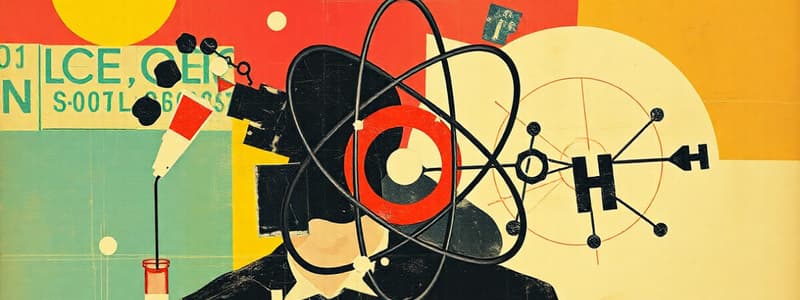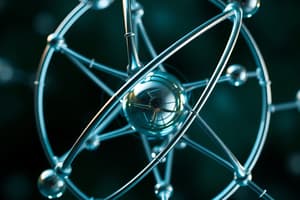Podcast
Questions and Answers
What is the basic unit of matter composed of protons, neutrons, and electrons?
What is the basic unit of matter composed of protons, neutrons, and electrons?
- Element
- Compound
- Molecule
- Atom (correct)
Which particles are positively charged and located in the nucleus of an atom?
Which particles are positively charged and located in the nucleus of an atom?
- Neutrons
- Protons (correct)
- Electrons
- Ions
What type of bond is formed when electrons are shared between atoms?
What type of bond is formed when electrons are shared between atoms?
- Metallic Bond
- Ionic Bond
- Covalent Bond (correct)
- Hydrogen Bond
What do we call a substance that releases hydrogen ions in solution?
What do we call a substance that releases hydrogen ions in solution?
What is a characteristic of a gas state of matter?
What is a characteristic of a gas state of matter?
Which of the following types of reactions involves the breaking down of a compound into simpler substances?
Which of the following types of reactions involves the breaking down of a compound into simpler substances?
What is the measure of the acidity or basicity of a solution called?
What is the measure of the acidity or basicity of a solution called?
What is the term for a unit used to measure the amount of a substance, equivalent to Avogadro's number?
What is the term for a unit used to measure the amount of a substance, equivalent to Avogadro's number?
Which of the following describes an endothermic reaction?
Which of the following describes an endothermic reaction?
What do we call combinations of two or more atoms that are bonded together?
What do we call combinations of two or more atoms that are bonded together?
Flashcards are hidden until you start studying
Study Notes
Basic Concepts of Chemistry
- Matter: Anything that has mass and occupies space. Exists in solid, liquid, and gas states.
- Atoms: Basic units of matter. Composed of protons, neutrons, and electrons.
- Molecules: Combinations of two or more atoms bonded together.
Atomic Structure
- Protons: Positively charged particles found in the nucleus.
- Neutrons: Neutral particles also located in the nucleus.
- Electrons: Negatively charged particles that orbit the nucleus.
Periodic Table
- Elements: Pure substances made of one type of atom, represented by symbols (e.g., H for hydrogen).
- Groups/Families: Vertical columns that share similar properties (e.g., alkali metals, halogens).
- Periods: Horizontal rows indicating the number of electron shells.
Chemical Bonds
- Ionic Bonds: Formed when electrons are transferred between atoms, resulting in charged ions.
- Covalent Bonds: Formed when atoms share electrons.
- Metallic Bonds: Involve a sea of electrons shared among a lattice of metal atoms.
Chemical Reactions
- Reactants: Substances that undergo a change in a chemical reaction.
- Products: New substances formed as a result of a chemical reaction.
- Types of Reactions:
- Synthesis: Combining elements to form a compound.
- Decomposition: Breaking down a compound into simpler substances.
- Single Replacement: One element replaces another in a compound.
- Double Replacement: Exchange of ions between two compounds.
Acids and Bases
- Acids: Substances that release hydrogen ions (H+) in solution; characterized by a sour taste.
- Bases: Substances that release hydroxide ions (OH-) in solution; characterized by a bitter taste and slippery feel.
- pH Scale: Measures the acidity or basicity of a solution, ranging from 0 (acidic) to 14 (basic).
States of Matter
- Solid: Definite shape and volume; particles are closely packed.
- Liquid: Definite volume but takes the shape of its container; particles are loosely packed.
- Gas: No definite shape or volume; particles are far apart and move freely.
Thermodynamics in Chemistry
- Endothermic Reactions: Absorb energy (heat) from the surroundings.
- Exothermic Reactions: Release energy (heat) to the surroundings.
Mole Concept
- Mole: A unit used to measure the amount of a substance, equivalent to Avogadro's number (6.022 x 10^23 particles).
- Molar Mass: The mass of one mole of a substance (g/mol).
Stoichiometry
- Stoichiometric Coefficients: Numbers used in balanced chemical equations to indicate the ratio of reactants to products.
- Balancing Equations: Ensures the law of conservation of mass is satisfied, with equal numbers of each type of atom on both sides.
Key Terms
- Catalyst: A substance that speeds up a chemical reaction without being consumed.
- Equilibrium: The state in which the rates of the forward and reverse reactions are equal, resulting in no net change in concentrations.
Basic Concepts of Chemistry
- Matter is anything that possesses mass and occupies space, existing in solid, liquid, or gas states.
- Atoms are the fundamental building blocks of matter, composed of protons, neutrons, and electrons.
- Molecules are formed when two or more atoms bond together.
Atomic Structure
- Protons are positively charged particles located in the nucleus of an atom.
- Neutrons are neutral particles also found within the nucleus.
- Electrons are negatively charged particles that move in orbits around the nucleus.
Periodic Table
- Elements are pure substances consisting of a single type of atom, symbolized by unique chemical symbols (e.g., H for hydrogen).
- Groups or families on the periodic table are vertical columns that contain elements with similar chemical properties, such as alkali metals and halogens.
- Periods are the horizontal rows in the periodic table that indicate the number of electron shells in the atoms of the elements.
Chemical Bonds
- Ionic bonds occur when electrons are transferred between atoms, resulting in charged ions.
- Covalent bonds are formed through the sharing of electrons between atoms.
- Metallic bonds involve a delocalized sea of electrons that are shared among a lattice of metal atoms.
Chemical Reactions
- Reactants are the initial substances that undergo transformation during a chemical reaction.
- Products are the new substances produced as a result of the reaction.
- Types of chemical reactions include:
- Synthesis: Combining elements to create a compound.
- Decomposition: Breaking a compound into simpler substances.
- Single Replacement: An element takes the place of another in a compound.
- Double Replacement: Ions are exchanged between two compounds.
Acids and Bases
- Acids release hydrogen ions (H+) when dissolved in water and typically have a sour taste.
- Bases release hydroxide ions (OH-) in solution and are characterized by a bitter taste and slippery feel.
- The pH scale measures acidity or basicity, ranging from 0 (very acidic) to 14 (very basic), with 7 being neutral.
States of Matter
- Solids have a definite shape and volume, with particles tightly packed together.
- Liquids have a definite volume but adapt to the shape of their container, with loosely packed particles.
- Gases have neither a definite shape nor volume, with particles that are far apart and move freely.
Thermodynamics in Chemistry
- Endothermic reactions absorb energy (heat) from their surroundings during the process.
- Exothermic reactions release energy (heat) into the surroundings.
Mole Concept
- A mole is a unit for measuring the amount of substance, defined as containing Avogadro's number (6.022 x 10^23 particles).
- Molar mass refers to the mass of one mole of a substance, expressed in grams per mole (g/mol).
Stoichiometry
- Stoichiometric coefficients are numerical values used in balanced chemical equations to represent the ratio between reactants and products.
- Balancing chemical equations is essential to adhere to the law of conservation of mass, ensuring an equal number of each atom on both sides of the equation.
Key Terms
- A catalyst is a substance that accelerates a chemical reaction without undergoing permanent change.
- Equilibrium is the state at which the forward and reverse reaction rates are equal, resulting in stable concentrations of reactants and products.
Studying That Suits You
Use AI to generate personalized quizzes and flashcards to suit your learning preferences.




